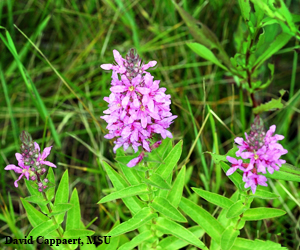Invasive Plants and Agricultural Pest Management
Welcome to Alaska's Invasive Plant Program. Our program coordinates prevention, outreach and management strategies for invasive plant issues through collaboration with land managers, agencies, organizations and policy makers across Alaska. These efforts are guided by the implementation of our Strategic Plan and relevant noxious weed regulations and policies. Our goal is to help keep Alaska's pristine landscapes and natural resources free from impacts of noxious and invasive plants.
PMC Programs
- PMC Home Page
- Horticulture
- Industrial Hemp
- Invasive Plants
- Plant Pathology

5310 S Bodenburg Spur
Palmer, AK 99645
Phone: 907-745-4469
Fax: 907-746-1568
Mon. - Fri.
8 a.m. - 4 p.m.
Click Map For Directions
View Larger Map
Purple Loosestrife (Lythrum salicaria)
AK Natural Heritage Program Invasiveness Ranking: 84
2007: Listed as a Noxious Weed in Alaska
Purple loosestrife is native to Europe and Asia, and originally introduced to North America as an ornamental plant. In its non-native areas it is known as the "beautiful killer" because of its ability to completely take over wetlands and displace native vegetation.
- Biology
- Impact
- Distribution
- Taking Action
- Resources
- • Herbaceous, wetland perennial
- • Grows up to 6-8 feet tall
- • Stems are erect and square with soft hairs
- • Leaves are simple, opposite or whorled, lance-shaped, slightly hairy and look somewhat crinkly
- • Flowers are rose to purple in color and are arranged in long vertical racemes
- • Individual flowers are composed of 4 to 8 green sepals and 4 to 8 pinkish purple petals surrounding a small, yellow center
- • Fruits are a two-chambered capsule containing many seeds
- • Individual plants can produce up to 110,000 seeds per season
- • Reproduces by root or seed
- **Purple loosestrife can be commonly confused with Alaska's native Fireweed. To tell them apart, Fireweed typically does not grow in wet or saturated soils, has narrow, lance-shaped leaves and the stem is not square.

Purple loosestrife was once available for purchase in nurseries and garden centers throughout Alaska up until 2007. Because of its aggressive growth habit, it has the potential to escape gardens into natural areas. When it does, purple loosestrife can suppress the resident plant community and eventually alter the wetland structure and function; clogging streams and canals, slowing water flow, shading out native plants and degrading nesting and forging sites for native animals. If this plant has an opportunity to establish in Alaska, economic value of our precious water resources could significantly decrease.
Purple Loosestrife has been found in several gardens in Anchorage and Juneau. One infestation was found in a natural area along Chester Creek in Anchorage and has since been eradicated. This map depicts the sites were it has been found in the past. These sites are still being monitored, but have since been eradicated of purple loosestrife since 2011. Since its listing as an Alaskan noxious weed, purple loosestrife is no longer available for purchase in the state, and it is illegal to transport.
Habitat: Moist or marshy sites, stream banks, shorelines and shallow ponds, typically favors clay, sand and silt.
Early Detection and Rapid Response (EDRR)! Controlling the spread of purple loosestrife is crucial to protecting fish habitat, wildlife and native plants. If found, please call 1-877-INVASIV.
The best time to control purple loosestrife is in late summer when it is easily recognized by its purple flowers, but before it goes to seed. Digging, hand-pulling and cutting are best for managing small infestations and have been successful, such as the Chester Creek infestation in Anchorage. The roots of purple loosestrife have the potential to sprout new plants, so care must be given to remove as much as the root system as possible. If the flower has gone to seed, take special care to properly remove seeds and prevent them from dispersing by disposing of them in a doubled-up plastic bag (plant material decomposes faster in plastic).
Chemical control has also been effective in managing smaller infestations of purple loosestrife in the lower 48. However, biological control of purple loosestrife has been a main method used in Minnesota's management plan.
